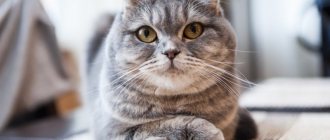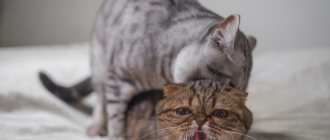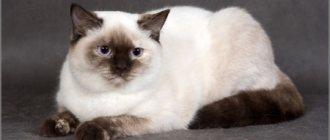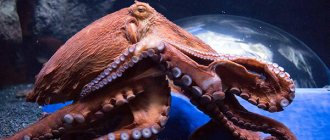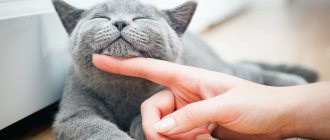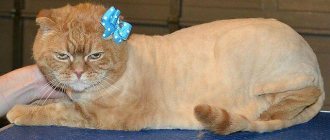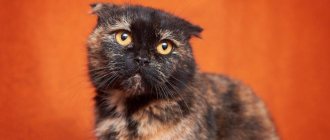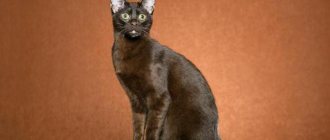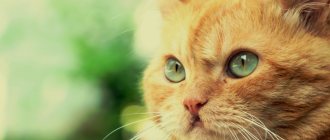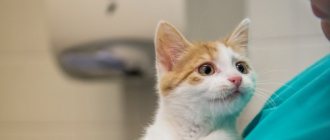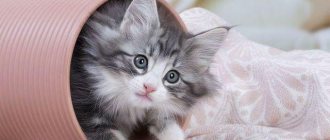Osteochondrodysplasia (OCD) is a disease that sometimes affects Scottish Fold cats due to their genetic makeup. There is no cure for this disease, but cats are prescribed supportive therapy, which improves the quality of life. This article is for those who want to obtain primary information about osteochondrodysplasia or verify data received from a veterinarian.
The first mention of skeletal deformities in Scottish cats dates back to 1971, although the breed was registered in 1966. Those. Not all cats had problems, so we didn’t notice them right away.
Article continues after advertisement
IMPORTANT TERMS
HIP DYSPLASIA is a discrepancy between the articular surface and the head of the femur, leading to a violation of the congruence of the hip joint. More often appears at a young age. It is expressed in a disturbance in the cat's gait and the inability to jump.
OSTEOCHONDRODYSPLASIA is a malformation of bone and cartilage, leading to a lack of normal growth of bone tissue and to its deformation. Translated from Greek, “dysplasia” means “disorder of education”; this term refers to a disorder in the development of tissues and organs. The disease is characterized by skeletal deformities and progressive osteoarthritis.
ACHONDROPLASIA is one of the forms of osteochondrodysplasia. The bones do not grow to normal size, and as a result, the cat's paws are abnormally short - dwarfism develops.
Scottish fold cats are at risk for this disease because... their breed-forming characteristic is the cartilage mutation gene, which deforms them. In other words, fold-eared cats (Scottish Folds and Highland Folds) have ears that “fall” because the cartilage has a fold. This defect is noticeable on the ears, but it also exists in other parts of the body. At the same time, the majority of Scottish fold cats live without knowing trouble, because... the defect is not developed enough to be visible. But it can also lead to the development of a disease called osteochondrodysplasia.
Opponents of the breed believe that all Scottish cats are sick, but this is definitely not the case. There is also an opposite opinion: a number of breeders claim that only those who have two Fd genes suffer from osteochondrodysplasia, i.e. children from incorrect crosses. Both points of view are not considered generally accepted. It would be more accurate to say that with proper crossing, when not two folds are brought together, but a fold and a straight (Scottish straight), the risk of the disease is minimized, because cats receive only one Fd gene. But life shows that the probability still remains (see the website of the Federation of Universities on Animal Welfare): it is difficult to predict who will be unlucky, even if the parents are clinically healthy.
The statement of a number of breeders that only heterozygous folds suffer from osteochondrodysplasia became the subject of lively discussions at one time, during which it was proposed to conduct a study of clinically healthy folds. But the research never began. As a result, the New Zealand Breed Standards Advisory Council (BSAC), in its report to the New Zealand Cat Fanciers (NZCF), noted:
Breeders underestimate the strength of the evidence that heterozygous individuals can develop OCD. Although research suggests that all lop-eared cats are susceptible to OCD, and anecdotal evidence also suggests, these studies do not show that parents with mild manifestations of the disease are likely to produce offspring with mild manifestations. The available information is not enough to definitively prohibit the breeding of Scottish Folds, but it is sufficient to understand the level of concern.
Due to the fact that heterozygosity of a fold does not guarantee its health, the Scottish Fold and Highland Fold breeds are considered extremely difficult to breed. All producers must be regularly screened for joint diseases and, if detected, the cat or female cat must be excluded from kitten breeding programs.
There is, in addition, the assumption of scientists that, because Most folds do not show any visible symptoms of OCD; there are one or more genes, in addition to the Fd gene, responsible for the development of this disease. Scientists are currently searching for these genes.
What affects health?
Scots, despite their charming appearance, are quite gentle and delicate in health for an experienced breeder.
In the process of raising Scottish Fold cats, you can encounter the following common diseases. These diseases, as a rule, do not directly affect the life of a young Scot, but they begin to actively manifest themselves in adulthood. Because of this, the pet begins to have problems with gait, running, and begins to limp. In turn, a lack of active games and entertainment leads to the development of obesity and a decrease in muscle mass. All these diseases can shorten the life of Scottish Folds by 3 or even 4 years.
- Grooming. Long-haired Scots breeds have surprisingly long hair, which without proper regular care can literally prevent the animal from moving. In addition, the formed wool tangles often become a haven for ticks and lice, as well as a source of development of inflammatory skin diseases. Poor grooming can also lead to physical inactivity (atrophy and weakening of the muscular system) if your pet does not move around much.
- Scottish Folds also love to lick themselves, which leads to swallowing a lot of long hair. Because of this, real hairballs and compactions often form in their stomach, which are then very difficult to remove from the body due to blockage of the passages. This can lead to complications in the gastrointestinal tract: diarrhea, constipation and loss of appetite.
In addition to the listed diseases, Scottish Folds are also characterized by other diseases typical of other cat breeds: skin diseases (fungal diseases, abscesses, abscesses, ulcers, rashes, allergic reactions), infectious diseases (salmonellosis, rabies, anemia, candidiasis), eye pathologies (pupil dilation, tear ducts, lens clouding), heart disease (hypertrophic cardiomyopathy), and some cancers.
Forecasts
The lifespan of Scottish cats affected by osteochondrodysplasia is difficult to predict in advance. It largely depends on how willing the owners are to care for a disabled kitten.
For long-term prognosis, it is necessary to exclude other genetic diseases of Scottish cats, which can occur with irresponsible breeding as often as osteochondrodysplasia. These are polycystic kidney disease and hypertrophic cardiomyopathy, which can be detected using ultrasound.
With mild osteochondrodysplasia, cats can live for years, although they require constant supportive treatment and special housing conditions. For example, they may find it painful to go to the toilet, which leads to urination in the wrong places and chronic constipation.
If the sick kitten is homozygous for the lop-eared gene (both parents are Scottish Folds), the prognosis for life is extremely unfavorable. Bone deformation causes severe pain, which becomes increasingly difficult to relieve with age. The animal cannot move, and at some point the owners resort to euthanasia as a means of ending the suffering of their beloved pet.
What ailments are there?
Diseases significantly shorten the life of fold-eared cats, so they may not live long depending on the disease. The most common:
- Osteochondrodysplasia. Characterized by skeletal deformation. Highland Fold and Scottish Fold breeds are at high risk of getting the disease. Straight-eared people are less susceptible. Proper treatment and care stops the disease and the cat can live to an old age.
- Hemophilia types A and B. Characterized by a blood clotting disorder and prolonged bleeding at the site of even a small cut. How many years Scottish cats with this diagnosis live depends on other anomalies of the body, since internal bleeding leads to rapid death.
- Eye diseases. A fold-eared or straight-eared cat often suffers from eversion or inversion of the eyelids, which provokes conjunctivitis, keratitis or blepharitis. Eye diseases do not affect a cat’s life expectancy if you consult a veterinarian in a timely manner and stop the inflammation.
- Ear ailments. The most common are otitis media, deafness and tumors due to the abnormal structure of the hearing organ. With proper care, your cat will live a long time. However, if the neoplasm is malignant, metastases may form and life expectancy will be significantly reduced.
- Deterioration of immunity. Pedigree cats have reduced body defenses, so they are susceptible to viral and bacterial diseases. Serious diseases (panleukopenia, rhinotracheitis) can “take away” your pet much earlier than expected.
- Metabolic disease. Spayed and neutered pets who suffer from hormonal imbalance suffer the most. This leads to obesity or diabetes.
Discussion
In humane medicine, low-dose radiation therapy is typically used to treat inflammatory and degenerative diseases, including painful symptoms of heel spurs, tennis elbow/golfer's elbow syndrome, painful symptoms of osteoarthritis and
hyperproliferative diseases.1–4 Although the mechanisms of the analgesic effect have not yet been elucidated in detail, their connection with the anti-inflammatory effect is suggested.1 Despite the fact that veterinary medicine has experience in using an experimental model of treating arthritis in animals using low-dose radiation therapy,5 information about clinical use of such treatment is insufficient. An example of the use of low-dose radiotherapy for the treatment of osteochondrodysplasia in the Scottish Fold is described in one animal of this breed;6 however, further studies with a larger sample size and longer follow-up are required.
The Scottish Fold cat breed was developed in Perthshire, Scotland in the early 1960s. In 1961, a white cat with folded ears was found on a local farm. This individual, which had a natural anomaly, became the ancestor of the Scottish Fold breed. The breed was entered into the British Cat Fancy register in 1966, but in 1974 the breed was banned in England due to cases of deafness and limb deformities (osteochondrodysplasia). Breeding of the breed continued in the United States, where it was registered in 1972.7–9 The Scottish Fold cat's appearance includes characteristic features: forward folded ears, large round eyes, a subtle curve of the nose and short thickened limbs. Due to its cute appearance and friendly disposition,7 the Scottish Fold is one of the popular breeds in Japan.
It is widely known that osteochondrodysplasia is an inherited disease of Scottish Fold cats.8,9 It is inherited as an incomplete autosomal dominant trait. The allele that determines the presence of folded ears is called Fd.10 Homozygous individuals (Fd/Fd) suffer from severe osteochondrosisplasia. In heterozygotes (Fd/fd), the disease has a milder course.10,11 To avoid the birth of homozygotes, it is recommended to cross lop-eared individuals with individuals having a normal ear shape.7,9 Homozygous individuals with normal-shaped ears are called Scottish Shorthairs, and they do not develop diseases.9 The described disease is characterized by deformations of the distal parts of the limbs and deformations of the skeleton of the tail.7 During pathohistological examination, defective development and functional inferiority of cartilage can be identified.12 Clinical manifestations are lameness and impaired tolerance to physical activity, in particular, the animal’s reluctance to jump and run because for chronically persistent pain. Because osteochondrodysplasia prevents a cat from engaging in a lifestyle that requires physical strength and agility, the cat's quality of life is likely to suffer.
This disease is an inherited disorder, and supportive care includes oral medications, surgery, and radiation to palliate chronic pain.6,11–13 Drug treatment, including nonsteroidal anti-inflammatory drugs, glycosaminoglycans, and pentosan polysulfate, has a moderate effect . Because Scottish Fold osteochondrodysplasia develops early in life, long-term use of drugs is not realistic.11,12 One publication reported temporary analgesic relief with osteotomy, but recurrence of lameness occurred after 48 weeks.13Hubler et al. described the use of radiation to both pelvic limbs in one Scottish Fold cat, which resulted in relief of pain, but after 28 months, bone proliferation was again noted.6 Although radiation is considered a promising treatment option for osteochondrodysplasia of the Scottish Fold, long-term efficacy and late complications have not been adequately assessed. The purpose of this publication is to evaluate the long-term effectiveness of radiotherapy in three Scottish Fold cats suffering from osteochondrodysplasia, as well as adverse events.
Radiation therapy resulted in relief of pain caused by osteochondrodysplasia of the Scottish Fold over a long period of time in all 3 cases (59 – 72 months). The mechanism that explains the analgesic effect of radiation in osteochondrodysplasia of the Scottish Fold is considered to be the effect on the inflammatory process leading to pain. .6 Human medicine has proposed a number of mechanisms that may explain this anti-inflammatory effect, including improved perfusion, release of a number of cytokines and enzymes, modulation of the expression of various molecules, local effects on the autonomic nervous system and innate immunity, and changes in pH values. .1,5,14,15 However, the specific mechanisms underlying the analgesic effect remain to be elucidated. The peripheral nervous system, including type C fibers, may play an important role in the analgesic effect. It is believed that nervous tissue is resistant to radiation, and according to the literature, the tolerant dose for nervous tissue, leading to complications in 50% of cases over 5 years (TD 50/5) in humans, is 75 Gy.16 For radiation damage to type C fibers they can still remain viable for 3-4 years. In all three cases, the pain syndrome was not completely resolved: the reluctance to move and the low level of activity of the animals became less pronounced during radiation therapy, however, when the affected limbs were stretched, each of the three cats felt pain. Therefore, a fractionated dose of 1.5 Gy with a total dose of 9 Gy could cause nerve fiber death. In addition, osteochondrodysplasia of the Scottish Fold occurs at a young age.10,12 Because the lesions identified were advanced in development, it is likely that the peak of pain in all three cases occurred at an earlier period, and this may be why the cats demonstrated the ability for quite a long time. bear the pain afterwards. Pathohistological findings in osteochondrodysplasia of the Scottish Fold allow us to identify defective development and functional inferiority of cartilage.12 In order to understand the reasons for the long-term persistence of the analgesic effect, as well as the nature of pathohistological changes after radiation therapy, further post-mortem (i.e. autopsy) studies are required.
Gradual progression of bone lesions was observed in cats in the second and third cases. In the first case, on the radiographs of the extremities of the right side of the body, which had been irradiated earlier, no findings were identified that were different from the radiographs of the left side, where irradiation was carried out later. It is believed that radiation therapy relieves pain without preventing the progression of bone lesions. It is noteworthy that the animal from Case 1 showed a clear improvement in clinical symptoms after the first sessions of radiation therapy, although no treatment was carried out on the limb on the left side. A decrease in the severity of pain in the right extremities could lead to the fact that the pain in general became below a certain level at which clinical signs can be observed.
There were no late complications, including alopecia, necrosis, or tumor growth. Because osteochondrodysplasia in Scottish Folds develops early in life, there is concern about the potential for adverse effects in the long term.17 The radiotherapy protocol we used was based on a single case report.6 A more appropriate protocol needs to be developed that takes into account both long-term effectiveness and the occurrence of late complications. The possibility of using radiation therapy additionally to treat recurrent pain should also be assessed. Although further observation is required, it is likely that all three animals will be able to survive for a long time and safely.
Osteochondrodysplasia of the Scottish Fold can develop in both homozygous and heterozygous cats with folded ears. In the first case, we considered the cat to be homozygous because all limbs were affected and the clinical manifestations were severe. Mild involvement of exclusively the pelvic limbs was observed in cats in Cases 2 and 3, so we considered them to be heterozygous. Although it was possible to determine the homo- or heterozygosity of animals using polymerase chain reaction,18,19 this study was not performed because genomic DNA could not be obtained from all three cats. Genetic confirmation is necessary to predict the severity of the disease in Scottish Folds. Since all three animals showed a satisfactory degree of improvement in clinical manifestations after radiotherapy, it can be considered as an effective therapeutic intervention for cats suffering from Scottish Fold osteochondrodysplasia of varying severity. Although radiation therapy is an effective and promising treatment for osteochondrodysplasia in Scottish Folds, it is only a supportive treatment. To completely eradicate osteochondrodysplasia in Scottish Folds, it is necessary to identify the gene responsible for the development of this disease. The main direction in the fight against osteochondrodysplasia of the Scottish Fold is to limit the breeding of cats with the corresponding gene. Finding the responsible gene would make it easier to breed Scottish Fold cats that do not suffer from osteochondrodysplasia. Breeding Scottish Fold cats with Scottish Fold osteochondrodysplasia is cruelty. In a number of countries and states, breeding cats with Scottish Fold osteochondrodysplasia is prohibited. Scottish Shorthair cats have the same characteristics as Scottish Folds, however they do not develop osteochondrodysplasia due to the absence of the defective gene described above. Therefore, instead of the Scottish Fold, breeding the Scottish Shorthair cat is recommended. In addition, osteochondrodysplasia is considered similar to congenital contractural arachnodactyly (Beals syndrome or Marfan syndrome). This pathological condition is characterized by pinna shrinkage and finger contracture, and can be considered a model of osteochondrodysplasia.
Radiation therapy has demonstrated its ability to provide long-term pain relief in cats with osteochondrodysplasia. No complications occurred in these three cases, although further lifelong monitoring is required. Radiation therapy has the potential to become a viable treatment option for osteochondrodysplasia in Scottish Fold cats.
How is the diagnosis made?
An examination is sufficient for a preliminary diagnosis. If you have a fold-eared kitten (or an adult cat) and you observe the following symptoms, you may suspect OCD:
– began to limp for no particular reason.
– the gait has changed. Protects one or more limbs, hunches over.
– there is a delay in growth, a violation of proportions (short legs, tail...).
– you observe deformation of the joints, most often the hind limbs are affected.
– the tail loses mobility, becomes like a “stick”, and when trying to bend the animal experiences pain.
To clarify, an x-ray is taken. The image evaluates the density of bone tissue, whether there are anatomical changes in the joints, the presence of bone exostosis (growth) and other changes.
The doctor may also recommend additional tests: general blood test, blood biochemistry, ultrasound…. In order to exclude other diseases or identify disorders that often develop in parallel with osteochondrodysplasia.
For example, kidney disease, mineral metabolism disorders, etc.
Causes of the disease
OCD, the abbreviated name for feline osteochondrodysplasia, is a genetic disease. The gene that is responsible for the formation of the auricle can play a cruel joke on the animal’s body as a whole.
What we see is a beautiful crease in the ear, this is only part of the picture. Changes in cartilage tissue, disruption of its formation, can occur throughout the entire skeleton, and affect not only the ear.
And cartilage tissue plays an important role, primarily mobility. Any joint, intervertebral joint... will not be able to function normally without healthy cartilage.
When the formation of cartilage tissue is disrupted, then we get complications, and they will manifest themselves to varying degrees.
The likelihood of developing osteochondrodysplasia depends on the parents. If both parents are lop-eared (folds), then the likelihood of developing OCD in the offspring is very high. If one parent is fold and the other is straight (with straight ears), then the disease rarely appears, but it can also happen.
Violations also occur if one parent is a Scottish Fold and the other is of any other breed. Yes, such a combination can also happen when breeding is not carried out by professional breeders. The demand for fold-eared kittens is high, so many people breed them.
Do straight-eared Scottish cats suffer from this?
The straight-eared Scottish Straight and Highland Straight varieties of Scottish cats are no more prone to osteochondrodysplasia than any other breed. The disease does not only affect Scots, it is just more common among Folds. Straits do not have deformed cartilages and do not have the gene for lop ears, and it is this gene that makes cats vulnerable to osteochondrodysplasia. By the way, not only the Scots are considered vulnerable for this trait, but also the Ukrainian Levkoy, in the selection of which Scottish Fold cats were used. OCD also occurs in humans. Therefore, it cannot be said that this disease is exclusively of the Scottish breed.
Rate and share!
How to extend the life of a pet
Let's find out what procedures will help your pet live longer:
Timely vaccination
Please note: even if your pet lives exclusively at home and never goes outside, harmful microorganisms can enter the house via outdoor clothing and other items. Balanced diet. If you prefer to give your cat commercial food, it should be premium or super premium.
Natural nutrition should include a large amount of protein: lean meat, fermented milk products, deboned sea fish once or twice a week. Vegetables are good for you. They can be given raw or cooked, depending on the cat’s preferences. Your pet should always have access to clean water. After consulting with a veterinarian, you can purchase mineral supplements for your pet to strengthen bones and cartilage tissue. Hygiene procedures are important. About 2 times a month you need to clean the animal’s ears using cotton pads and a special gel (sold in pet stores). A short-haired pet should be brushed once a week using a brush with short, stiff, dense teeth. The long-haired variety of Scottish cats is combed daily using a comb with sparse long teeth. It is not advisable to use slicker coats for Scots. Sterilization increases the life of a pet by 2–3 years (regardless of gender).
Do not forget that how long your pet will live largely depends on you.
Symptoms and development of the disease
The disease usually develops in adult Scottish cats, but the first signs, missed by cat owners, may appear in kittens during the period of “dropping” of the ears (Scottish Folds are born straight-eared).
During the period of intensive development of the disease, its symptoms become obvious. Here are the most common ones:
- the animal's tail has a disproportionately thin base;
- the gait changes, unnatural growths called exostoses appear on the paws - they prevent the cat from moving normally;
- loss of flexibility of the tail, its thickening as a result of the proliferation of cartilage tissue, also observed in the area of the limbs;
- deformation of the jaw apparatus: changes in bite, curvature of the jaw, protruding teeth;
- thickening in the joint area, imbalance in the proportions of the body and head;
- development of a painful symptom when walking, which the animal signals by anxious meowing and refusal to play outdoor games;
- slower skeletal growth;
- Difficulty jumping onto various surfaces.
If you find at least one of the alarming signs in your pet, you should immediately contact your veterinarian. Only a doctor can confirm or deny the presence of a mutation.
“Vulnerable” places of Scottish folds
Scottish Fold is classified as an undemanding strong breed. But every artificial species has “vulnerable” places.
What problems do owners of fold-eared cats encounter?
- Diseases of the musculoskeletal system. In adulthood, problems with the development of bone and cartilage tissue begin.
- Cats easily gain excess weight as a result of a sedentary lifestyle and an unbalanced diet. This gives impetus to liver and heart dysfunction, and the risk of serious problems increases.
- The ear is the weakest point of the Scottish Folds. Responsible owners of fold-eared cats regularly inspect their pets' ears and clean them of dirt and wax. Otherwise, an inflammatory process appears and enters the chronic stage.
- Long-haired cats suffer from the appearance of dense mats due to insufficient coat care. This reduces mobility and negatively affects muscle tissue throughout the body.
Be sure to read: Lilac British cat: features of the breed’s appearance, characteristics, behavior, care
There are diseases that are most often inherited by Folds.
What diseases do cat owners face:
- Osteochondrodysplasia. Health problems can be identified by lameness and hardening of the tail.
- Osteoarthritis is joint stiffness.
- Hypertrophic cardiomyopathy is a problem with the functioning of the heart.
- Polycystic kidney disease.
What you need to increase your cat's lifespan
In order for a pet to live 15-20 years, it is important to carefully approach its purchase and follow all the recommendations of specialists when caring for it. There are several tips that are usually given to those who decide to get a Scottish kitten:
- Contact a trusted breeder and choose a healthy kitten with special care.
- Let it be a female, since female Scottish cats live a little longer than males.
- Follow all veterinarian recommendations and get vaccinations on time.
- Ensure the kitten's safety by removing wires and anything that could injure him.
- Sterilize the animal in a timely manner.
- Don't let him go outside.
- Feed correctly, preferably natural food.
- Provide your pet with communication, affection, and play with him more often.
Appearance. What do Scottish Folds look like?
A striking feature of this breed is its erect ears. Among canine representatives there are many breeds whose ears do not stand up - Labradors, pugs, collies, spaniels, Airedale terriers, bulldogs, shelties, retrievers and others. The cat population cannot boast of such diversity; only the ears of the Scots, and with rare exceptions of the British, hang, and do not stand upright. This determines the popularity and unusualness of the breed.
Interesting fact: the second name of the breed, often found in veterinary reference books and books on animal care, is Scottish Fold.
The size of the cat is average: Scottish Folds have a medium-sized body with a rounded shape, with powerful and well-developed muscles, the shoulders and chest are well developed. The paws are thick, of medium length, massive and large, with delicate rounded pads. The color of the wide, bright eyes with mysterious sparkles varies depending on the color of the coat.
The jaw is well developed; a large oval or round head gently transitions into a wide neck; the ears are small, rounded towards the bottom; the nose is large and wide.
The coat is medium length, soft to the touch, like plush; tail of medium length, rounded at the end. The color can be any: breeders have bred seventy-five species of these wonderful animals.
Healthy pet weight
By external signs and forms, you can indirectly assess the health and physical condition of the Scottish cat breed. The most important parameters are:
- The British body is medium to large, slightly elongated;
- Muscle mass: muscular, strong;
- Powerful limbs of medium length, with large paws;
- The weight of a purebred adult Scot reaches from 3.5 to 6.0 kg.
Cat weight
How much a male Scottish cat weighs can be estimated from his appearance; he has a larger head, a wide muzzle, and is proportionally built. Stands confidently on large paws. As a kitten, it develops and gains weight much faster than a cat, its weight per year is from 4.5-5 kg, and a neutered cat can weigh more, up to 8 kg. Such cats have an important appearance and are distinguished by calm habits and temperament.
Cat weight
A healthy purebred Scottish cat looks much smaller and sleeker than a cat; on average, it should weigh up to 3.5 kg per year; an adult, strong cat can weigh up to 5 kg.
How long do cats usually live?
Representatives of small cats in the wild live relatively short lives - 5-6 years. The lifespan of stray cats is approximately the same. Reasons for this:
- poor diet;
- irregular meals;
- invasive diseases;
- infections;
- lack of protection from predators;
- stress associated with the struggle for survival;
- harsh climatic and weather conditions.
The shortest lifespan—4 years—is for cats that, by chance, end up on the street. After a comfortable stay at home, they do not adapt well to the new environment. The fate of neutered cats is even sadder: being unable to compete for a place in the hierarchy, they immediately become outcasts from the pack and do not live more than three years. A little more time—approximately 3.5 years—is given to cats whose bodies are exhausted by constant pregnancies, childbirth, and nursing offspring.
Different fate and life expectancy for cats with loving owners
Care and attention, human patronage, and the opportunity to receive veterinary care allow them to live 15 years or more
The absolute champion in survival is the cat Lucy. At the time the record was entered into the Guinness Book (2011), according to the owners, she was 39 years old.
Return to content
Information disclosure
None of the authors of this article received financial support from third parties or organizations that could unduly influence the content or lead to bias in the presentation.
Statement of Potential Conflict of Interest
: The authors declare no conflict of interest.
Statement on off-label use of antimicrobials
: The authors declare that there is no off-label use of antimicrobials.
How to increase the lifespan of a Scotsman
Thanks to many advances in veterinary medicine and the development of the pet business, the lives of pets have become much longer and more comfortable. To ensure that 15 years is not the limit for the life expectancy of a Scottish Fold, its owner must be responsible, starting with the choice of a kitten and throughout the pet’s life.
You should only purchase a fold-eared baby from a conscientious, reputable breeder or at a cat show.
This solution minimizes the risk of purchasing a sick animal. Particular attention should be paid to issues of maintenance and care. Even before the furry newcomer appears in the house, you need to decide on the type of food he will eat, whether it will be factory-made food or natural products. When choosing ready-made food, preference is usually given to the “super-premium” and “holistic” classes: these lines take into account the age, breed and individual characteristics of cats. A natural diet should be balanced, varied, meeting the needs of carnivores in general and Scottish Folds in particular: contain not only all nutrients, but also taurine, which Scottish cats, like all other cats, do not produce on their own.
- Routine and preventive examinations by a veterinarian are required, as well as timely vaccinations against rabies, panleukopenia, chlamydia, calcevirosis, and rhinotracheitis.
- Given the propensity of the Scottish population for cardiomyopathy and the difficulty in diagnosing this disease, ultrasound of the heart and chest should be included in the examination.
- Monitoring the condition of the gums and teeth must be constant: dental problems lead to diseases of the digestive system.
- If breeding a breed is not the purpose of purchasing an animal, it is advisable to sterilize it in due time.
- Regardless of whether the Scottish Fold is outdoors or in contact with other animals, periodic anti-parasitic measures are required.
- To maintain muscle tone and good shape, your pet needs to be provided with physical activity through games and training.
Such careful care and sincere love will allow the Scottish Fold to live to the respectable age of twenty.
Return to content
Prevention and hygiene of paws
Quite often you can see a cat washing itself. She licks her paws thoroughly. Cat saliva contains the enzyme lysozyme, which has a pronounced antiseptic property. It is this substance that ensures the hygiene of the paws and all places that the animal licks.
If an animal visits the street, it is a good idea to wash its paws with lukewarm water and wipe with a napkin. If the walk happened in the rain, then you should wash the dirt more thoroughly.
Some owners limit themselves to wiping their paws with special wet, scented wipes. This cannot be done. Such napkins are impregnated not only with “perfume” but also with other substances, and the animal, by licking its paws, can swallow the remains.
The basis of lump prevention is inspection and palpation. When playing or stroking an animal, you can always notice on or under the skin:
- seals;
- wounds;
- areas of skin without fur;
- cones;
- growths.
Any foreign body that is not familiar to the animal should alert you. While observing an animal, it is easy to spot a place of increased interest. It is necessary to immediately examine it to identify the cause.
A timely visit to a specialist will help identify the pathological process at the initial stages, establish a diagnosis and provide timely, qualified assistance.
When to castrate a Scottish Fold cat
Castration of cats is a simple operation that is traditionally performed in every veterinary clinic and lasts no more than 20 minutes. First, the animal is given anesthesia (intravenously or intramuscularly), then small incisions are made in the skin of the scrotum, after which the spermatic cords are ligated and the testes are removed directly. After surgery, cats do not need stitches. The stump is treated with antiseptics, and a standard set of medications is administered (antibiotics, hemostatic agents).
In general, castration of cats always follows the same scenario, regardless of breed. The only question that needs to be resolved before the operation concerns the age of the animal of a particular breed. So, at what age are Scottish Fold cats neutered?
The optimal age for surgery to remove the testes in fold-eared cats is 10–12 months. This is the time when the cat reaches puberty. Some veterinary clinics offer castration of fold-eared cats at the age of 8 or even 6 months. Professional breeders categorically do not recommend doing this, since a disproportion of the head to the rest of the body may occur if the cat has not yet developed to its condition. As a result, the head will be too small compared to the weighty butt.
However, you shouldn’t delay castration too long, because if the cat has already become acquainted with the cat and periodically marks its territory, then after the operation he can continue to do this. But even in this case, the risk is no more than 10%.
Thus, the question of when to castrate a Scottish Fold cat depends on the speed of onset of puberty in him, which can be determined by certain signs:
- the smell of urine becomes stronger;
- the animal becomes restless and aggressive;
- the cat refuses to eat;
- the animal meows loudly and rushes around the apartment.
The above changes in the behavior of your pet are a reason to immediately contact a veterinary clinic.
Skin diseases
Unfortunately, Scottish cats are susceptible to skin diseases. A large number of varieties of diseases are difficult for the owner to diagnose independently, without veterinary experience. Symptoms are similar to allergies, scabies, eczema and demodicosis.
Based on typical signs of occurrence and development, skin diseases in the Scottish breed can be classified into three characteristic groups:
- Infectious:
- bacterial (strepto, staphyloderma), these include acne, folliculitis;
- fungal infections ringworm: trichophytosis and microsporosis.
Attention! Infectious skin diseases of animals are contagious not only to animals, but also to humans. When caring for a pet, it is necessary to observe hygienic and sanitary rules and isolate the Scotsman from other brothers.
- Non-infectious skin lesions include diseases that arise as a result of a decrease in the body’s immunity, such as:
- allergies, dermatitis, reaction to any allergen: food, tray filler, plant pollen, detergent chemicals and much more;
- eczema, a complex allergic reaction caused by disruption of the internal organs of the Scots: liver, endocrine, hormonal system;
- Bedsores can occur in a chronically ill cat when lying for a long time, when blood metabolism begins to be disrupted and the upper layers of the skin die;
- alopecia, baldness is often caused by neurosis, when the cat finds itself in a stressful situation.
- Parasitic skin lesions include the reproduction of various parasites on the skin, ears and other places, such as scabies and other types of mites, fleas, lice and lice.
All skin diseases are pathogenic in nature and cause attacks of aggression in the pet:
- Severe itching, with scratching of the skin until wounds form;
- They provoke shedding, excessive loss of part of the fur, leading to the formation of bald spots;
- the appearance of wounds with purulent discharge.
Skin diseases harm the health of pets, and if urgent measures are not taken and professional treatment is not provided to the pet, the animal may die.
Hanging belly
When a cat has hanging skin on its stomach, this is not a pathology, but a genetic formation, which has the scientific term “primordial sac”. Popularly called fat tail, it is a natural property of wild felines. The Scottish cat breed has a hanging pedigree or rudimentary fold. In short-haired Scottish Straight and Scottish Fold cats, when the cat's belly hangs, it is more noticeable than in long-haired Highland Straight and Highland Fold cats.
The skin fold has a plumb line of 3-5 cm and stretches along the lower abdomen from the stomach to the paws. There is no scientific explanation for this feline feature yet.
Growths on the paws
This is a genetic pathology of Scottish Fold cats. The growths appear as a result of osteochondrodysplasia, which begins to appear in the early stages of development, so all owners need to monitor the condition of the pet’s limbs. At the first signs of the appearance of growths on the limbs, contact a veterinary clinic, where your pet will be examined. This disease cannot be cured, but prescribed medications will stop the further development of the disease and relieve acute attacks of pain in a sick pet.
What to feed a cat with osteochondrodysplasia
The basis of nutrition for sick cats is proper balanced feeding using supplements that prevent fractures and joint destruction. It is desirable that the food be natural, but factory-made feed can also be used. If we are talking about ready-made food, then these are complexes containing vitamins, macro- and microelements. Supplements and the diet itself should be rich in calcium, vitamins B and E, phosphorus, iodine and iron. Among professional food brands there are even special lines for cats with joints. Such feeds and supplements additionally contain chondroitin and glucosamine, which in combination mutually enhance each other.
If the cat eats a natural diet, then it should include raw cartilage, sinew and meat, rich in natural glucosamine and chondroitin. But the opinion about the need to cook jellied meats for such cats is wrong. All the substances that were originally in the cartilage and meat are no longer present in the digestion, and many pass into a form that is difficult to digest. Everything you need is already in the raw product.
It is also worth considering that cats with joint diseases are susceptible to obesity, because it is unpleasant or even painful for them to move. The owner must monitor the calorie content of the diet by regularly weighing the animal and identifying deviations in time. If the cat is already obese, it is necessary to select food for weight loss, because... excess fat threatens heart disease and greater stress on the musculoskeletal system. If your cat is of normal weight, still try not to overfeed her, because... a cat with reduced physical activity needs fewer calories.
Diet
Since osteochondrodysplasia causes thinning of cartilage tissue, as well as deformation of the animal’s bone skeleton, a balanced diet and proper care are the key to making your pet’s life easier.
When choosing food for a sick animal, it is worth considering a side effect of low physical activity: obesity. In addition, Scottish cats, which are close relatives of British shorthairs, inherited from their common ancestors a breed tendency to quickly gain weight. Therefore, you need to control the calorie content of your food.
Cat food manufacturers have developed a special line of food products for animals with pathology of cartilage tissue. Such feeds contain all the necessary vitamins and microelements, such as calcium, selenium, phosphorus.
Scottish breeders recommend the following nutritional supplements: POLIDEX Multivitum, Hill's Prescription Diet and Holistic food, Primitive Feline Natural Cat Food.
If a Scottish cat suffering from OCD is accustomed to a natural diet, it is necessary to include in its diet foods rich in microelements and vitamins to strengthen cartilage tissue. However, it is not recommended to heat food, as it destroys important components of a healthy diet.
List of products needed for Scottish cats with OCD:
- Lean varieties of meat, which are given raw (to preserve trace elements in the composition), but are pre-frozen so as not to infect the animal with parasites.
- Fermented milk products (hard cheese, kefir, fermented baked milk) rich in calcium.
- Quail eggs.
- Special cat grass, rich in vitamins and minerals.
How long do sick cats live?
It is unlikely that anyone will give you a specific prognosis for the life expectancy of cats with osteochondrodysplasia. Unless such responsibility will be assumed by the treating veterinarian who has fully examined the animal. And even then the forecasts are often wrong. Also, veterinarians often mistakenly suggest euthanizing a seriously ill animal or cutting off a limb, although, in fact, with the correct selection of medications and proper care, as well as the patience and love of the owner, the cat’s condition can be seriously improved. Therefore, do not be upset immediately as soon as you hear from the doctor that the cat has no future. Be sure to consult with 1-2 more veterinarians. Only then make a decision!
The first signs of osteochondrodysplasia in Scottish fold cats can appear as early as a couple of months, so when choosing a kitten it is so important to pay attention to the behavior of the cat, the curvature of the paws, the presence of kinks in the tail, its mobility and length. It all starts with minor changes that may not be noticed if you don’t set such a goal. In most cats, the disease becomes noticeable later, when they have already found permanent homes.
In most cats, the disease becomes noticeable later, when they have already found permanent homes.
The rate at which the disease progresses and its severity varies among individuals. The time of visible manifestation of the disease is the same. However, veterinarians recommend that all owners of fold-eared cats closely monitor the condition of the pet and, at the first signs, run to the veterinary clinic, because further quality of life will directly depend on how early treatment is started.
To increase the life expectancy of a sick cat, it is necessary, in addition to drug therapy, to balance the diet and prevent the appearance of excess weight, because it creates additional stress on the musculoskeletal system.
Pets with especially severe manifestations of the disease once again try not to move. Sometimes it is even difficult for such cats to reach the litter box, and therefore they may relieve themselves in the wrong place or on their own. If this has become a system, you can purchase special cat diapers. Then the cat will urinate and poop in them, thereby saving you from unnecessary problems.
If your cat is diagnosed with such a disease, we would like to advise you not to despair. For inspiration, watch a video about a rescued cat with osteochondrodysplasia, who, due to illness, was kicked out of the house by her owners in 40-degree frost, but a few days later she was rescued by volunteers, came out, and now she lives happily in a new family.
However, in some cases it is still recommended to euthanize the cat. These are cases of severe progressive disease with pain. If the animal is suffering, cannot lead a normal life, is constantly on pills that do not help much, veterinarians advise stopping the cat’s suffering. And in this case they are most likely right. However, the final decision is up to the owner.
Case 2
A 2-year-old neutered male Scottish Fold was referred to the Veterinary University Hospital of the Japan Veterinary and Life Sciences University due to chronic pain in the pelvic limbs for 3 months. Clinical manifestations were relieved by the administration of meloxicam, but recurred after discontinuation of the drug. The animal resisted palpation of the pelvic limbs. Despite the obvious shortening of the limbs, their deformation was not noted.
X-rays of all four limbs, tail, abdominal organs and chest were performed. In the area of the calcaneus of the left pelvic limb, there was fresh growth of bone tissue, and the presence of osteophytes of the tarsal joints on both sides was noted. No other lesions of the bones of the thoracic limbs or tail were detected during radiography.
The animal was diagnosed with Scottish Fold osteochondrodysplasia and followed up for 59 months. In order to relieve the manifestations of chronic pain syndrome, irradiation of the pelvic limbs was carried out according to the protocol described above. Clinical manifestations resolved after 1 month from the start of radiation therapy. No acute adverse effects were observed in the irradiated areas. At the end of the course of radiation therapy, radiography was performed regularly. At the 4th month, the appearance of plantar exostosis was noted. There was progression of exostosis up to 26 months, but by 59 months no further progression was noted. There was continued growth of osteophytes of the right tarsal joint up to 50 months, but no further progression was noted by 59 months. No late complications were identified during this period. The animal's condition was stable and meloxicam was not required.
Rice. 1. Radiographs of the limbs and tail of the animal from Case 1. 1-1 Radiographs at the time of diagnosis (0 months). (A) Right wrist joint (lateral view).
(B) Left wrist joint (lateral view). (C) Both carpal joints (dorsoventral view). (D) Both tarsal joints (dorsoventral view). (E) Right tarsal joint (lateral view). (F) Left tarsal joint (lateral view). (G) Tail (ventro-dorsal view). (H) Tail (lateral view). 1–2 Series of radiographs of the thoracic extremities at 12, 24, 36, and 60 months. Radiographic findings did not change over time. 1–3 Series of radiographs of the pelvic limbs at 12, 24, 36, and 60 months. Radiographic findings did not change over time.
Rice. 2. Case 1 animal 60 months after radiation therapy. Although the limbs and tail showed obvious shortening, thickening and deformation, these lesions were indistinguishable from the lesions at the time of diagnosis. (A) Muzzle and floppy ears. (B) Tail. (C) Thoracic limbs. (D) Phalanges and paw pads of the thoracic limbs. (E) Right pelvic limb. (F) Phalanges and paw pads of the pelvic limbs.
Treatment
The success of treatment for feline OCD depends on the degree of damage to the skeletal system. The earlier the disease is detected, the greater the chance of a good prognosis. Already developed skeletal changes persist until the end of life, but adequate therapy can slow down or even stop their further development.
In any case, treatment measures are primarily aimed at eliminating the main symptoms of osteochondrodysplasia: relieving pain, inflammation and joint stiffness. If your pet does not suffer from kidney disease, he may be prescribed non-steroidal anti-inflammatory drugs: Meloxivet, Ketoline, Ainil.
To stimulate the proper development of cartilage tissue, Pentosan can be prescribed, which has a chondroprotective and anti-inflammatory effect, as well as glycosaminoglycans involved in the construction of the cartilage matrix:
- Chondroitin-4-sulfate;
- Chondroitin-6-sulfate;
- Furinaid;
- Interpan.
These drugs slow down the processes of degeneration of bone and cartilage tissue and maintain the amount of synovial fluid in the joint capsule at the proper level.
Manual therapy or massage can alleviate the animal’s condition, but these physical procedures must be performed by a professional specialist. In severe cases of osteochondrodysplasia, your pet may need surgery to remove bone growths called exostoses that have formed on the joints. After such an operation, the cat’s lameness usually decreases and pain is partially or completely relieved. In some countries, radiation therapy is used to treat OCD.
Important! To improve the quality of life of a cat suffering from osteochondrodysplasia and increase its life expectancy, in addition to drug therapy, it is necessary to organize a balanced diet and prevent the development of obesity, since excess weight is an extra load on the skeletal system weakened by the disease. If your cat has signs of osteochondrodysplasia, his diet should be special
The diet must include specialized supplements that help strengthen bone and cartilage tissue: calcium, phosphorus, iron, iodine, B vitamins. This will prevent the possibility of fractures and slow down degenerative processes
If your cat has signs of osteochondrodysplasia, his diet should be special. The diet must include specialized supplements that help strengthen bone and cartilage tissue: calcium, phosphorus, iron, iodine, B vitamins. This will prevent the possibility of fractures and slow down degenerative processes.
Veterinarians consider the best food option for cats with OCD to be natural, home-cooked food. If ready-made feeds are used, then you should choose specialized complexes intended for animals with diseases of the musculoskeletal system. Such complexes contain all the necessary vitamins, macro- and microelements.
Osteochondrodysplasia in a Scottish fold cat is not a death sentence. With timely detected pathology, proper treatment and competent, caring care, your pet can feel good and live a long life.
- Feliferon for cats
- Chelavit for cats
- What food to feed a British cat
Case 1
An intact female Scottish Fold cat, less than 12 months of age, was admitted to the Veterinary University Hospital of Japan Veterinary and Life Sciences University (VMTH-NVLU) due to exercise intolerance due to chronic pain syndrome lasting several months. During palpation, the animal was practically motionless and demonstrated that this type of examination caused discomfort. The cat had short, massive and deformed limbs; Large plantar exostoses were noted, as well as changes in the shape of the claws. There was overstretching of the skin of the soles due to exostosis. There was a large thickness and low flexibility of the tail. There was no history of any treatment.
X-rays of all four limbs, tail (Fig. 1), abdominal organs, and chest were performed. X-rays of the thoracic limbs revealed fresh bone growths in the area of the carpal bones, metacarpus and phalanges. Shortening, thickening and disruption of the shape of the metacarpal bones in the distal section, as well as the phalanges, were noted. On the pelvic limbs, fresh bone growths were identified in the area of the tarsal and metatarsal bones, as well as the phalanges. These bones were also short, dense and misshapen. Radiographs of the tail revealed bone growths, as well as shortening and deformation of the caudal vertebrae. There was a narrowing of the intervertebral spaces, while the caudal vertebrae were in direct contact. X-ray examination of the chest and abdominal cavity revealed no other bone lesions.
Based on the animal's breed, symptoms and clinical manifestations, as well as radiographic findings, the cat was diagnosed with Scottish Fold osteochondrodysplasia. Due to the severity of the disease, the owner abandoned the animal. One of our employees agreed to become the new owner, from whom informed consent was obtained. As a measure of palliative treatment of chronic pain syndrome, radiation therapy was performed to the extremities on the right side. In order to evaluate the effectiveness, as well as complications, irradiation of the extremities was performed only on one side. The treatment plan was developed from X-ray CTa using treatment planning software based on 3D reconstructions.b During treatment sessions, the cat was anesthetized and placed in a supine position on a vacuum immobilization mattressc shaped to follow the contours of the patient's body. The limbs were wrapped in artificial skin (to adjust the radiation dose), but no blocks, wedges, or multileaf collimator were used. Palliative radiation was performed using a 4 MV linear accelerator.d The protocol included 6 fractionated doses of 1.5 Gy each on a Monday-Wednesday-Friday schedule for a total dose of 9 Gy.
Clinical manifestations resolved after 2 weeks from the start of radiation therapy. Radiography was performed (Fig. 1). No progression of the disease was detected. No acute complications, including alopecia, pigmentation, and wet desquamation, occurred. There were no radiographic differences between exposed and unexposed limbs. By 38 months, the animal was admitted due to severe pain in the extremities of the left half of the body that were not exposed to irradiation. Radiation therapy of the left thoracic and pelvic extremities was performed according to the protocol described above. The animal was observed for 60 months. At month 60, there were no late complications of radiation therapy, including aplopecia, bone or nerve necrosis, or tumor growth (Fig. 2). The cat willingly walked, ran and jumped. No changes in the morphology of bone lesions were detected according to radiography.
What is OHD
Translated from Greek, “osteo” means bone, and “dysplasia” means a developmental disorder. OCD is a genetic malformation of cartilage and bone tissue, leading to a slowdown in their growth. The result of this pathology is underdevelopment of the osteochondral system, including the ear cartilage (which is why cats of this breed have “falling” ears). Systemic skeletal lesions are most often expressed by deformation of the limbs. This disease often does not pose a direct threat to the animal’s life, but can significantly reduce its quality and duration.
Important! The purebred Scottish Fold and Highland Fold breeds are at risk for this disease. Both of them have a “defective” gene in their pedigree
If one of the cat’s parents was a Scottish Straight (Scottish Straight or Highland Straight), he will inherit one mutated gene, and the animal’s chances of developing osteochondrodysplasia will be halved.
Case 3
A one-and-a-half-year-old intact female Scottish Fold was admitted to the Veterinary University Hospital of the Japan Veterinary and Life Sciences University due to lameness on the right pelvic limb of one year's duration. The animal could not jump. The cat resisted palpation of the right pelvic limb and did not land on it when jumping. There was no history of any treatment.
X-rays of all four limbs, tail, abdominal organs and chest were performed. The presence of bone tissue growth in the area of the tarsal, metatarsal and calcaneal bones on both sides was determined. Osteophytes were detected in the area of the tarsal joints on both sides. Radiographs of the tail revealed shortening and deformation of the caudal vertebrae. No lesions were found in the thoracic extremities.
Based on symptoms and clinical manifestations, as well as radiographic findings, the cat was diagnosed with Scottish Fold osteochondrodysplasia. Radiation therapy was performed on both pelvic extremities according to the protocol described above. Clinical manifestations resolved after 1 month from the start of radiation therapy. No acute adverse effects were observed. When X-rays were performed regularly over 16 months, no progression of bone lesions was detected. At 48 months, new zones of deformation were noted in the area of the tarsal joints on both sides, but this did not affect the activity of the animal. Further follow-up was 72 months without additionally identified pathologies. No late complications were noted.
What affects life expectancy
The main factors that determine a cat's lifespan include:
- heredity;
- conditions of detention;
- quality of diet;
- characteristics inherent in a particular breed;
- availability of veterinary care;
- features of the permanent habitat.
In addition, sterilized pets live several years longer than their counterparts who have preserved their reproductive organs: surgical intervention eliminates the possibility of infection through contact with an infected partner, as well as the development of diseases of the genitourinary system in older cats.
The so-called free range, and in fact - unsupervised stay on the street, increases the risk of death of a domestic cat from the aggression of other animals, various injuries, accidents, and dangerous infectious diseases. The life expectancy of a free-roaming cat is much shorter than that of a indoor pet.
Return to content
Diagnostics
Clinical signs of osteochondrodysplasia in cats are quite typical, so preliminary diagnosis is based on a visual examination of the animal. In cats with OCD, in addition to the characteristic external signs described above (short, deformed paws, stiff gait, sedentary tail), palpation of the limbs reveals bone growths (exostoses) located in the heel bone area. If they are large, the skin over the growths becomes bald and ulcerations may appear on it.
To confirm the diagnosis, an X-ray examination is performed (options include tomography or MRI). Depending on the degree of damage to cartilage and bone tissue, the following may be visible on x-rays:
- abnormalities in the shape of the bones of the hand, metatarsus and heel segment;
- irregular shape of the tail vertebrae;
- narrowing of joint spaces;
- the formation of bone growths around the joints of the limbs.
Clinical signs
Pathology usually manifests itself in cats at 1.5-2 months. At this age, it is already quite well expressed, since osteoarthritis (degenerative process of bone tissue) has time to develop in the bones. The most typical symptom of OCD is limb deformity. The hind legs of a cat with osteochondrodysplasia are shortened, so he is forced to groom on semi-bent front legs. Due to the inflammatory process in the bones, the animal experiences constant pain, so it tries to move less. The pain syndrome can cause lameness, stiffness of gait, and the cat has difficulty jumping high and jumping down.
External signs of osteochondrodysplasia are also considered:
- enlarged head;
- crooked teeth, protruding jaw;
- flattened, disproportionately short nose;
- inactive short tail with a thin base.
Helpful information! If you are purchasing a Scottish Fold kitten, pay special attention to the mobility of the tail (this is easy to determine by palpation) and gait, which should not be constrained in a healthy animal.
